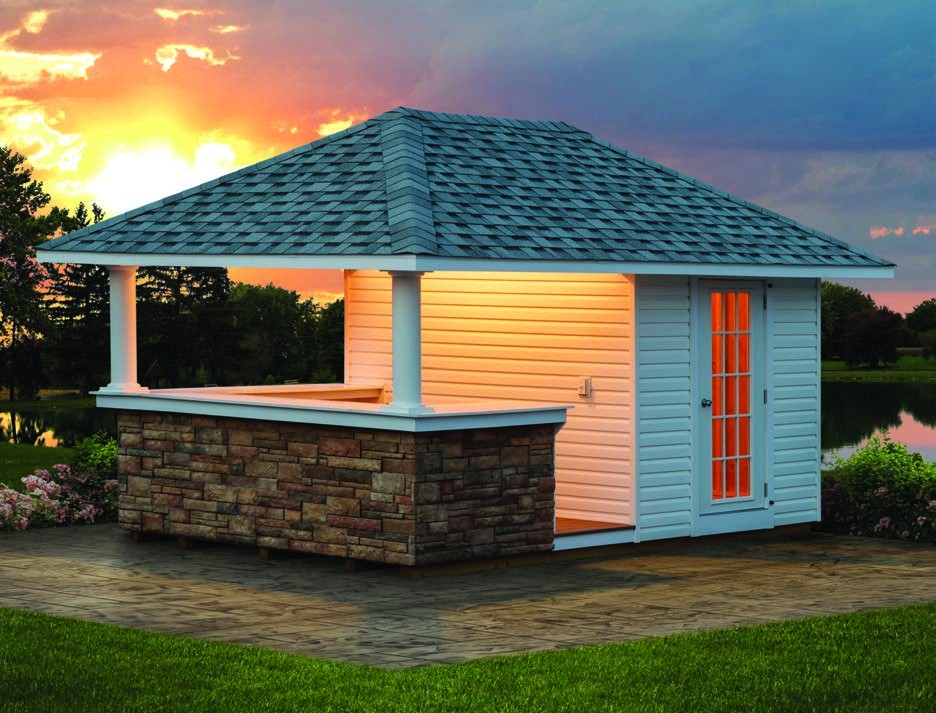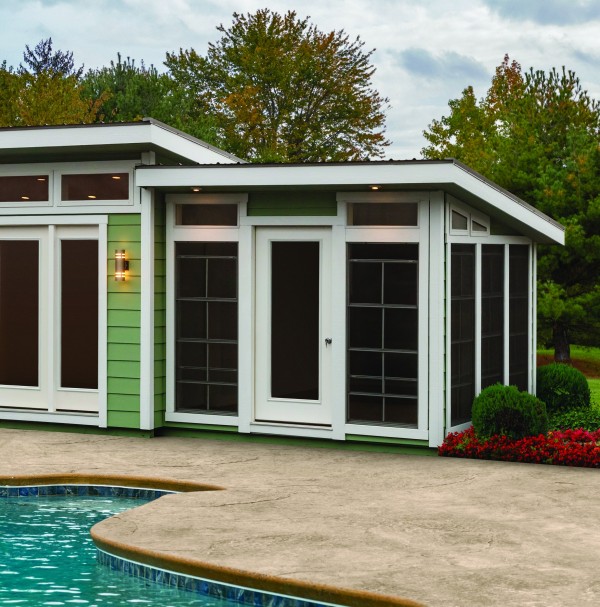Smart Storage

With summertime comes many opportunities to entertain or enjoy the backyard, but that also means lots of clutter in the form of patio furniture, pool toys, games and more. Where does all of that stuff go at the end of the party, or better yet at the end of the season when fall arrives?
When the basement is already full with old baby clothes or holiday decorations, and the garage is packed with cars and sports equipment, many homeowners opt for a customized shed for storage or even as a bonus space for relaxation.
House & Home spoke with several area professionals to learn more about the styles and materials available for sheds, what factors to consider before having one added to the property and other trends in the industry.


Starting the process
For homeowners who are considering a shed for their yard, the first step is to determine exactly what they want to store.
“First we hear them out and see what their needs are,” says Dave Zook of Stoltzfus Structures. “We try to get an idea for what they’re looking for, because someone living in a trailer court who wants to store his motorcycle and other equipment is totally different from someone who has a million-dollar property and wants to have the building … fit into the look and feel of the property. So we get a feel for their needs to determine if functionality is more important than looks.”
Sheds can come in handy for all types of storage needs, from large items like lawn mowers and lounge chairs to smaller objects such as noodles for the pool.
“People want to store anything from pool equipment to lawn furniture to garden supplies,” says Jake Fisher of B&L Woodworking. “A lot of people just have everyday storage needs and are looking to store their extra things.”
“It can be garden tools, shop tools, pool equipment, pool accessories, bikes, motorcycles—all kinds of stuff,” adds Jake Stoltzfus of Barnco Woodworks.
Dan Stoltzfus of Country Tyme Sheds thinks it makes sense for people to start out by seeing the different types of sheds available for themselves.
“The best thing is for the customer to come out to the lot and walk around,” he says. “We have 70-plus sheds, so there are all kinds of different colors and style options to look at. We handle everything, from the stone face to the deliveries.”
 Styles and materials
Styles and materials
With all of the different types of sheds available, choosing a style can be overwhelming, so having a professional to guide the way is beneficial. At the end of the day, though, it usually just comes down to customer preference.
“There are tons of styles and options to choose from,” Fisher says. “The A-frame, the Quaker and the Cape Cod are the three most popular styles we sell.”
The A-frame is often preferred by those in residential neighborhoods because of its similar look to the house. Quaker and Cape Cod both offer classic looks, while other varieties include the hip roof with slopes on each side or the flat roof. A basic style that is usually the least expensive and used just for storage is the barn.
Stoltzfus Structures can customize sheds in all or most of these styles and even differentiates between storage sheds and garden sheds.
“If you want to ratchet it up a notch and take it to the next level, that’s when you go with a garden shed,” Zook says. “That’s the next level up as far as looks and cost. You’re going from a Chevy to a Lexus.”
The list of material choices is just as extensive. Country Tyme’s Stoltzfus says LP SmartSide is their most popular seller, but vinyl is an old reliable and often a go- to for people looking to match their house. Cedar, shiplap and stone are other options.
 “There are so many choices; it’s incredible,” he says. “It all depends on your budget and what you’re trying to accomplish.”
“There are so many choices; it’s incredible,” he says. “It all depends on your budget and what you’re trying to accomplish.”
Fiber cement siding from James Hardie is a pricier way to go, but according to Barnco’s Stoltzfus, it’s worth the extra cost.
“A lot of homes are being built with that and customers who know Hardie know the value of Hardie,” he says. “The Hardie is your best siding. The vinyl siding lasts a long time too, but you can’t run your lawnmower or your weed wacker up against it.”
Still, a vinyl shed remains popular because it requires little maintenance, while wood sheds are selected by those looking to save a buck.
“For a vinyl shed versus a wood shed, you’re paying a little bit more for convenience,” Zook says. “You’re never going to have to paint it and basically it’s a lifetime product. You have to paint [a wood shed] every 10 years or so, and if you don’t maintain it, there’s a chance of it rotting on you.”
However, Country Tyme’s Stoltzfus touts a new stain product available that can make wood or wood siding hold up longer.
“It’s a little bit more money but you can use this special stain now,” he says. “It’s only been out for a few years so we’re waiting to see how long it lasts, but from what I’ve seen so far, it looks like the cat’s meow. It’s great.”
Sizes and design elements
A typical size for a backyard shed is usually 12 by 20 feet or 12 by 24, but it can range from 6 by 8 to 24 by 40 and even bigger. Determining factors include the size of the property, what the homeowner is looking to store and, of course, budget.
Another key factor in the size of the shed is where the customer lives.
“The size of the shed depends on the size of the property and what township they’re in,” Fisher says. “A lot of townships have a restriction on how big people can go with their shed. They will allow you to go to a certain square footage before you need to get a building permit. That’s something the customer needs to find out, because they’ll also have to keep their shed [a certain] amount of feet from the property line to stay within the township guidelines.”
As for design elements, many homeowners will look to dress up the shed to make it stand out from the rest of the neighborhood.
“There’s everything from flower boxes to shutters,” Zook says. “There are more functional uses like lofts and second stories, or you can make it prettier and add stuff like cupolas. There’s a whole slew of options.”
Adds Barnco’s Stoltzfus: “We do custom at no charge, meaning we’ll place your doors and windows where you want them and you also pick the color that suits your needs. We do flower boxes, round-top windows, round-top doors, square doors—the list goes on and on.”
Other uses for sheds 
All of the experts who spoke to House & Home agree that the latest trend centers on adding a shed not just for storage, but also as a bonus living space. She sheds, man caves and even home offices are just some of the possibilities.
“We make quite a few that are for bars or man caves, and we also do a lot of pool houses,” Jake Stoltzfus says. “They can be used for she sheds, studios, gym rooms. It’s an outdoor living space, really is what it is.”
“That’s very popular today,” Dan Stoltzfus agrees. “People like to give themselves a place to escape and also to use for storage.”
RESOURCES
Barnco Woodworks
Berlin, N.J.
(856) 767-6887
Swedesboro, N.J.
(856) 241-7660
BarncoAmishBuilders.com
B&L Woodworking
Princeton, N.J.
(609) 924-4479
BLWoodwork.com
Country Tyme Sheds
Colmar, Pa.
(267) 834-0211
CountryTymeSheds.com
Stoltzfus Structures
Atglen, Pa.
(610) 595-4724
MySheds.com
Select images courtesy of Barnco Woodworks, Country Tyme Sheds.
Published (and copyrighted) in House & Home, Volume 20, Issue 1 (July/August 2019).
For more info on House & Home magazine, click here.
To subscribe to House & Home magazine, click here.
To advertise in House & Home magazine, call 610-272-3120.
